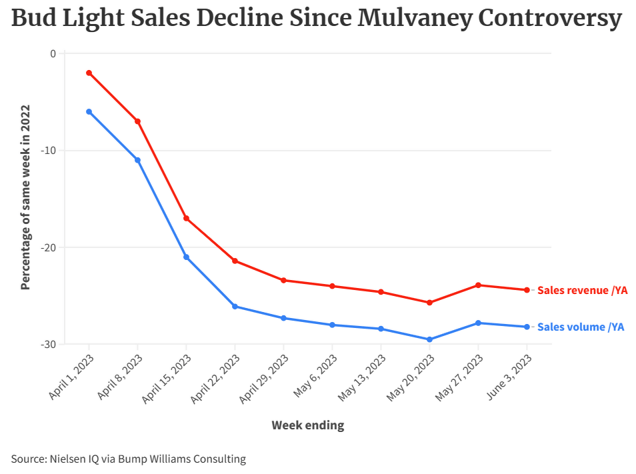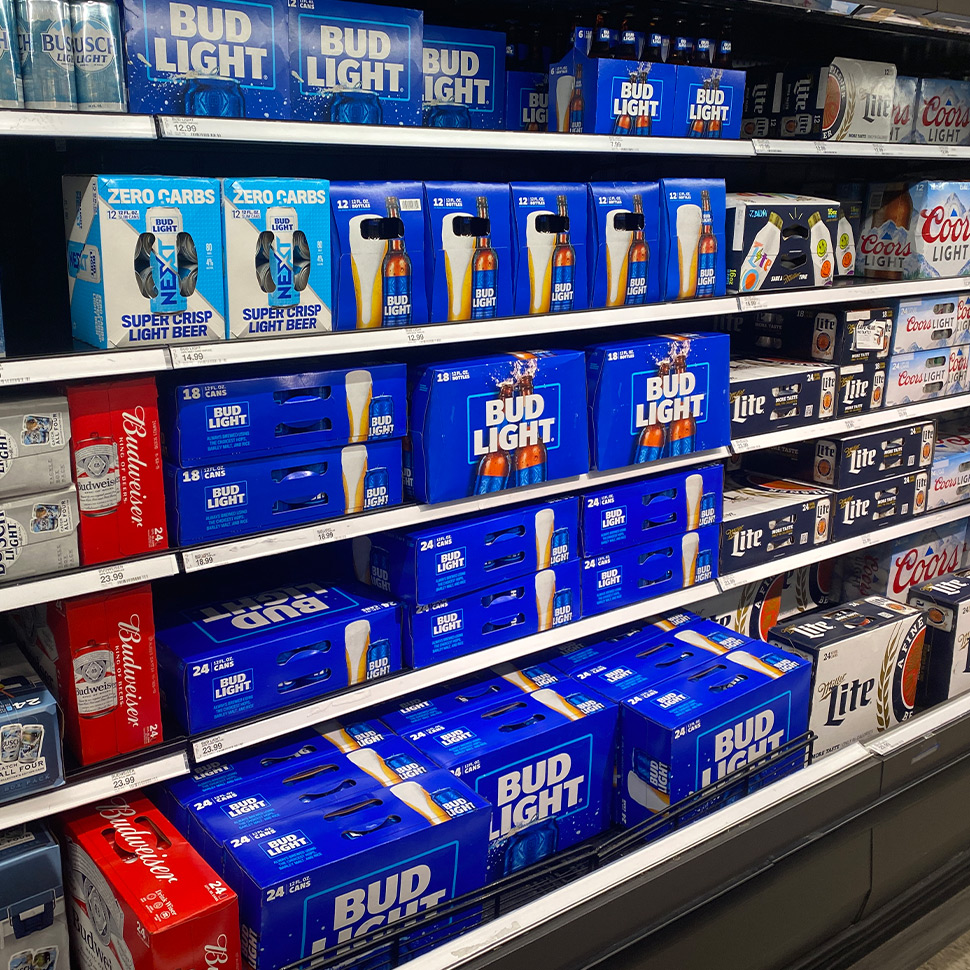
Bud Light, a brand of Anheuser-Busch InBev (AB InBev), has declined sales due to various factors. Customers have been turning away from the brand, and its US revenue per 100 liters has also decreased. Despite this, AB InBev has been trying to regain customers and turn things around. In this article, we will provide an overview of the decline in Bud Light’s sales and discuss its significance.
Overview of Bud Light’s decline in sales
According to Dave Williams, Vice President of Analytics and Insights at Bump Williams Consulting, unless Bud Light experiences a serious course correction in terms of performance, its grip on the No. 1 rank will continue to loosen every week. In May, Bud Light was ranked No. 1 with $333 million in sales, a 15% increase from 2022. However, its sales have been declining since then.

Bud Light’s customers turned away from the brand after it partnered with a transgender influencer and then muddled its response. As a result, AB InBev’s sales to US retailers declined nearly 17%, primarily due to the volume decline of Bud Light. In response, the company cut deals with wholesalers to distributors and on the brand. Sales of Bud Light are still sinking, with volumes down 30% year-over-year for the four weeks ending on October 7, according to NIQ data given to Beer Business Daily newsletter.
Significance of the decline in sales
The decline in Bud Light’s sales is significant as the brand has been the top-selling beer in the US for decades. However, its ongoing backlash has led to a 5% decline in third-quarter US revenue per 100 liters, a key measure of beer sales. This decline has affected AB InBev’s overall revenue and market share, leading the company to take measures to regain customers.
AB InBev is hopeful that it can turn things around, as over 40% of lapsed Bud Light customers said that they are willing to give the brand another chance, according to the company’s research. However, it remains to be seen whether the company’s efforts will successfully bring back customers and restore Bud Light’s position as the top-selling beer in the US.
Bud Light’s Revenues in 2020
Bud Light’s revenue in 2020
In 2020, Bud Light’s revenue continued to decline as the beer’s popularity faded. According to reports, its parent company, AB InBev, announced a 12.8% decline in revenue globally for the third quarter, with a 0.5% decline in the United States.
Bud Light’s revenue specifically was not provided by the company, but it can be assumed that its decline contributed to the overall decrease in revenue.
Comparison of revenue in 2020 to previous years
Bud Light’s revenue decline in 2020 was not a sudden development. The brand had been struggling for years due to what many consumers viewed as a mediocre product, below-average customer satisfaction, and egocentric management decisions. In 2019, Bud Light’s parent company saw a 1.4% decline in revenue globally, with a 3.2% decline in the United States. By August of that year, Bud Light’s sales had declined 26.8%, while rival Modelo’s sales grew 15.9%. The trend continued into 2020, with reports of a continued decline in revenue and the brand’s parent company announcing layoffs.
Overall, the data suggests that Bud Light’s issues extend beyond a single triggering event or incident, such as the controversy with a transgender influencer or the Mulvaney incident. The decline in revenue is multi-faceted, and likely due to a combination of factors, including increased competition, a lack of differentiation from competitors, and management decisions that alienated customers.
Reasons for Bud Light’s Decline in Sales
Bud Light, the world’s best-selling beer brand, has been struggling to maintain its dominance in recent years. Several factors have led to the decline in revenue for the brand, including:
The negative impact of the conservative backlash
One of the main reasons for Bud Light’s decline in sales was the conservative backlash against the brand. In 2019, the brand faced backlash from conservative consumers who were angered by a commercial that seemed to mock their values.
The backlash led to calls for a boycott of the brand, and many consumers switched to rival brands. This incident showed the power that consumers have to hold brands accountable and highlighted the possible negative impact of polarizing marketing campaigns.
The effect of commemorative can cause controversy
Bud Light also faced controversy in 2019 when it released commemorative beer cans that featured two women with the words “The perfect beer for removing ‘no’ from your vocabulary for the night” printed on them. This marketing campaign faced a lot of criticism for promoting rape culture and was seen as inappropriate by many consumers. The controversy led to a decline in sales for Bud Light and showed the need for brands to be mindful of the messages they are promoting in their marketing campaigns.
Sales decline due to volume decline of Bud Light
Finally, the decline in revenue for Bud Light can also be attributed to a decline in the volume of beer sold. According to reports, Bud Light’s sales volume declined by 6.7% in 2019, leading to a decrease in revenue. The trend has continued in 2020, with reports of a continued decline in sales and the brand’s parent company announcing layoffs.
In conclusion, the decline in revenue for Bud Light is due to a combination of factors, including controversial marketing campaigns, increased competition, and a lack of differentiation from competitors. The brand will need to address these issues and develop a strategy for regaining its position in the market if it wants to remain a dominant player in the beer industry.
Impact on the US Beer Industry
Comparison of Bud Light’s sales decline to overall beer industry decline
Bud Light’s sales decline has significantly impacted the wider beer industry in the United States. In 2020, the brand’s parent company, AB InBev, announced a 14% decline in sales to US retailers, underperforming the overall beer industry. The decline in revenue for North America alone was $395 million compared to the same period the previous year. This suggests that the brand’s issues were not limited to isolated incidents but were reflective of broader trends in the beer industry.
Reasons for under-performing the wider beer industry
One of the primary reasons for Bud Light’s under-performance and subsequent impact on the US beer industry is increased competition. The craft beer industry, which has been steadily growing over the past few years, has led to a fragmented market where consumers have more choices than ever before. As consumers have become more discerning, the lack of differentiation between Bud Light and its competitors has made it less attractive to those seeking new and unique options.
Another significant factor is management decisions that have alienated customers. The 2019 Super Bowl advertisement campaign by Bud Light that poked fun at rival brands using corn syrup as an ingredient was seen as arrogant and needlessly divisive, leading to a backlash from many in the industry. Additionally, the decision to sponsor a transgender influencer led to a backlash from right-wing media and anti-trans commentators, resulting in further alienation of customers.
Overall, Bud Light’s decline in revenue and sales has had an impact on the US beer industry as a whole, with decreased revenue for North America alone being $395 million compared to the same period the previous year. The decline can be attributed to increased competition, a lack of differentiation, and management decisions that have alienated customers.
Revenue in North America
Comparison of revenue in North America during 2019 vs 2020
In 2020, AB InBev reported a decline in revenue for North America, including Canada. The company stated that sales to US retailers declined by 14%, under-performing the wider beer industry primarily due to the decline in the volume of Bud Light it sold. Revenue in North America fell by $395 million during the period compared to the same time a year ago. This suggests that the decline in revenue was not limited to isolated incidents, but was reflective of broader trends in the beer industry.
In contrast, revenue in Canada actually rose during the period. This indicates that the slump in revenue was likely isolated to the United States and that the losses on Bud Light may have been even greater than reported.
Analysis of revenue increase in Canada
Despite the decline in revenue for North America, the rise in revenue in Canada is noteworthy. One possible reason for this increase is AB InBev’s focus on diversification and innovation in the Canadian market. The company has made efforts to introduce new products and to appeal to Canadian tastes, which may have contributed to the increase in revenue. In addition, AB InBev has invested in the development of its Canadian supply chain, which may have improved the efficiency of its operations and reduced costs.
Another possible factor is the relative stability of the Canadian beer market compared to the US. Unlike in the US, the craft beer industry in Canada has not experienced the same explosive growth, which has allowed larger, established brands like Bud Light to maintain their market share. Furthermore, the Canadian government’s regulation of the beer market has limited the number of players, reducing the level of competition compared to the US.
In conclusion, while revenue in North America declined for AB InBev during the period under review, the rise in revenue in Canada suggests that the slump was isolated to the United States. Possible reasons for the decline in revenue in the US include increased competition, a lack of differentiation, and management decisions that have alienated customers. Conversely, the rise in revenue in Canada may reflect AB InBev’s efforts to diversify its product offering, improve its supply chain, and appeal to Canadian tastes.
AB InBev’s Cost-Cutting Measures
Cost-cutting measures implemented by AB InBev in 2020
Like many other businesses, AB InBev introduced cost-cutting measures in 2020 to defend its global lead in the beer industry. These measures involved reducing expenses across the organization, including layoffs of some US corporate staff. The company’s aim was to streamline operations and reduce costs amidst declining revenue and sales.
Correlation between cost-cutting measures and Bud Light’s decline in sales
AB InBev’s cost-cutting measures have been linked to the decline in sales of Bud Light, the company’s top-selling brand in the United States. The measures implemented led to an increase in competition and a lack of differentiation between Bud Light and its competitors. This made the brand less attractive to consumers, especially those seeking new and unique options. The management decisions that alienated customers, such as the Super Bowl advertisement campaign and the sponsorship of a transgender influencer, also contributed to the decline in sales.
In May 2020, Bud Light lost its ranking as America’s best-selling beer, leading to a 14% decline in US sales to retailers and a 10% fall in US revenue for AB InBev in the second quarter. The impact of Bud Light’s decline was not limited to isolated incidents but was reflective of broader trends in the beer industry. The decline had a significant impact on the wider beer industry, with decreased revenue for North America alone being $395 million compared to the same period the previous year.
In conclusion, AB InBev’s cost-cutting measures were a response to declining revenue and sales in the company. However, these measures led to increased competition, a lack of differentiation, and management decisions that alienated customers, all of which contributed to the decline in sales of Bud Light. The correlation between AB InBev’s cost-cutting measures and the decline in Bud Light’s sales underscores the need for a strategic and comprehensive approach that prioritizes customers and the changing needs of the beer industry.
Layoffs in US Corporate Staff
Announcement of AB InBev’s layoffs in US corporate staff
In 2020, Anheuser-Busch InBev (AB InBev), the world’s largest brewer, announced layoffs in its US corporate staff. The company stated that it would be reducing the workforce by close to 2% across every corporate function, which equates to about 380 employees out of the roughly 19,000 employed in the US. The layoffs were part of the company’s overall cost-cutting measures in response to declining revenue and slumping sales, particularly for its flagship brand, Bud Light.
Reason for layoffs
The layoffs were a result of AB InBev’s cost-cutting measures, which aimed to reduce expenses across the organization and streamline operations amidst declining revenue in the beer industry. The layoffs in the US corporate staff were part of a global effort to cut costs, which included reducing production, marketing, and other expenses. AB InBev’s cost-cutting measures were necessary to defend its global lead in the industry but had unintended consequences.
The correlation between AB InBev’s cost-cutting measures and the decline in sales of Bud Light underscores the need for a comprehensive and strategic approach that prioritizes customers and the changing needs of the beer industry. The management decisions that alienated customers, such as the Super Bowl advertisement campaign and the sponsorship of a transgender influencer, also contributed to the decline in sales.
In conclusion, AB InBev’s layoffs in its US corporate staff were a response to declining revenue and sales of its flagship brand, Bud Light. The company’s cost-cutting measures, including layoffs, were implemented to streamline operations, reduce expenses, and defend its global lead in the industry. AB InBev’s cost-cutting measures inadvertently contributed to the decline in sales of Bud Light, emphasizing the importance of a comprehensive and customer-centric approach to meet the changing needs of the beer industry.
Bud Light’s Ranking in America
Comparison of Bud Light’s ranking in 2019 vs 2020
Bud Light, the top-selling beer in the United States, lost its ranking as America’s best-selling beer in 2020. This is a significant decline compared to its position in 2019, where it held the number one spot for over two decades. Bud Light’s decline in sales in 2020 was attributed to the COVID-19 pandemic and the introduction of cost-cutting measures by its parent company, AB InBev.
In 2019, Bud Light sold over 27 million barrels in the United States alone, accounting for almost 15 percent of all beer sold in the country.
The brand’s revenue totaled to $7.9 billion in the same year, making it the top-selling beer brand in the US. However, in 2020, Bud Light’s U.S. dollar sales fell by 29% in the four weeks ending Oct. 21 compared to the same period the previous year. Additionally, the beer’s U.S. revenue fell by 13%, leading to a decline in the beer’s ranking in the country.
Impact of losing rank as America’s best-selling beer
The impact of Bud Light’s decline in sales went beyond just the revenue loss for AB InBev. The loss of its ranking as America’s best-selling beer caused significant brand damage and a shift in consumer preferences. The introduction of new players in the market such as Modelo Especial and White Claw had a significant impact on Bud Light’s market share. Consumers’ quest for new and unique options, as well as the changing landscape of the beer industry, contributed to the brand’s lull in sales.
The decline in Bud Light’s sales also impacted the beer industry as a whole. AB InBev’s overall revenue decreased by 5% year-over-year (YoY) in 2020, leading to a decline in revenue of $3.8 billion for North America alone. The impact of the decline was felt across all aspects of the industry, from brewery workers to distributors, and even retailers.
In conclusion, the decline in Bud Light’s ranking in America can be attributed to various factors. The COVID-19 pandemic, cost-cutting measures by AB InBev, and the entrance of new players in the market have all contributed to the decline. Bud Light’s decline in sales has caused significant brand damage, leading to a shift in consumer preferences and a decline in revenue for AB InBev. The impact of the decline in Bud Light’s sales highlights the need for companies to be agile, strategic, and customer-focused to remain competitive in the beer industry.
Summary of reasons for Bud Light’s decline in sales
The decline in Bud Light’s ranking in America can be attributed to various factors, including:
– The COVID-19 pandemic
– Cost-cutting measures by AB InBev
– The entrance of new players in the market
Future implications for AB InBev and the beer industry
The impact of Bud Light’s decline in sales highlights the need for companies to be agile, strategic, and customer-focused to remain competitive in the beer industry.
AB InBev has since undertaken various investments to appeal to evolving consumer preferences, including the introduction of low and no-alcohol options and pushing its premium beer brands. The beer industry should also be prepared to adapt to changing consumer preferences to remain successful.
Conclusion
Bud Light’s decline in sales led to the loss of its ranking as America’s best-selling beer and caused significant brand damage. The decline can be attributed to various factors, including the COVID-19 pandemic, cost-cutting measures, and new players in the market.
Brands in the beer industry must remain agile and strategic to remain competitive, and the industry as a whole must adapt to changing consumer preferences. AB InBev has since undertaken various investments to appeal to evolving consumer preferences, and the industry should follow suit to remain successful.


